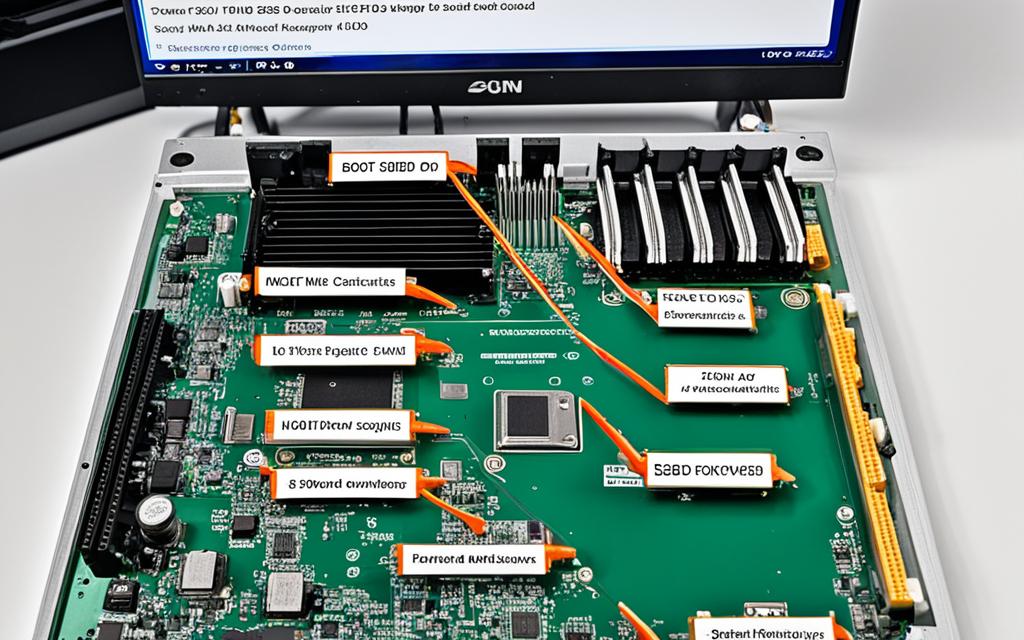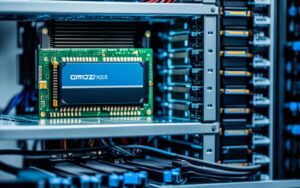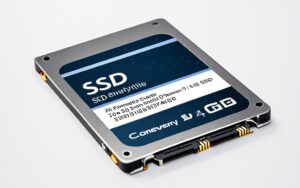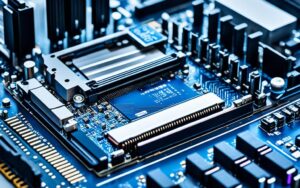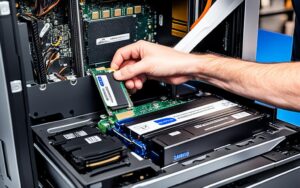Table of Contents
Today’s tech world offers various storage solutions that can greatly change your computing experience. Choosing to boot from an SSD (solid-state drive) is now common because it’s much faster and more reliable than traditional HDDs (hard disk drives). This guide aims to show you all the necessary steps for a successful SSD installation, making sure your boot drive works perfectly.
Through this guide, learn how to get your SSD ready, move your operating system to it, and tweak BIOS settings to make the SSD the main boot device. Switching to an SSD could truly upgrade how your computer works. With helpful advice, unlocking this boost is easy and straightforward. Learn more about configuring your SSD for the best performance.
Key Takeaways
- SSDs offer quicker, more dependable performance than HDDs, ideal for boot drives.
- Switching to an SSD can noticeably improve boot times and how fast applications start.
- Choosing an SSD upgrade can majorly boost your system’s performance.
- It’s important to think about how much storage you need for your boot drive.
- A smooth move to an SSD means a hassle-free upgrade experience.
Understanding SSDs and Their Benefits
Solid-State Drives, or SSDs, have changed how we use computers. They offer huge benefits compared to older Hard Disk Drives (HDDs). With their speedy access to data, SSDs make computers work much faster, enhancing how we experience them.
The Advantages of SSDs Over HDDs
SSDs bring a lot of advantages to the table. They have faster read and write speeds, meaning your computer starts and loads things almost instantly thanks to flash memory1. Unlike HDDs, which have moving parts, SSDs work much quicker, loading pages and apps fast2. SATA SSDs can achieve speeds up to 550 MB/s, much more than HDDs can manage3.
For durability, SSDs are the winners. They’re tougher and last longer because they don’t have parts that move. This makes them great for devices you carry around2 and for using every day1.
Why You Should Consider Upgrading to an SSD
Choosing an SSD can open up many benefits. With an SSD, you’ll see your computer start up much quicker and handle data better3. As SSDs get more affordable, upgrading is becoming a smart choice for more people3. They also use less power, so if you use a battery-powered device, it’ll last longer3. Switching to SSD isn’t just an option; it’s a wise move for a smoother computing experience.
Preparing Your SSD for Booting
Getting your SSD ready for booting involves a few key steps. These steps help your system run better and faster. First, you need to physically install the SSD in your computer.
Physical Installation of the SSD
Begin by gathering the necessary tools, like a screwdriver. Make sure you have the right cables too. Secure the SSD in your computer case and connect it to the motherboard. This is key to making sure your computer works well and quickly.
You then decide if you want a fresh start with a new system or to move over old data. For help with this, check out this detailed guide. It covers everything from cloning to fresh installs, showing why SSDs are a great choice.
Enabling the SSD in BIOS
After fitting the SSD, you need to activate it in the BIOS. Restart your computer and go into the BIOS menu to find your SSD. Make sure it’s set as the primary boot device.
This step is necessary for fast start-ups and quick data access. Remember to save these changes before you exit the BIOS. If you’re unsure about this step, here’s a helpful guide for further help45.
How to Boot from an SSD
Switching to an SSD can greatly improve your system’s speed and efficiency. To move your operating system to the SSD, follow these essential steps. They will make the process smoother and enhance your setup’s performance.
Steps to Migrate Your Operating System to the SSD
Firstly, check the SSD has enough space and back up important files. Then, you’ll have ways to efficiently move the OS to your new SSD. A common method is using cloning software like EaseUS Todo Backup to make things easier. The time this process takes can vary, from ten minutes to over half an hour, based on how much data you have.
Methods for Cloning Your Existing OS
Cloning your OS to a new SSD is simply making a copy. However, you might face issues if cloning fails, or the SSD doesn’t show up in BIOS. Before starting, make sure you’re cloning the OS, not a data drive. If the cloned SSD won’t boot, retry cloning with trusted software. Adjusting BIOS settings is key to ensuring the SSD boots correctly after cloning. For tips on expanding your computer’s storage, check out this link6. Knowing how to boot from an SSD correctly can help fix problems for a smoother experience.
Setting the SSD as the Boot Drive in BIOS
Once you’ve moved your operating system to the SSD, you must make it your primary drive in the BIOS. This step is about changing the boot order so that your computer starts up from the SSD. By doing this, your computer’s speed will greatly improve.
Adjusting Boot Order Settings
To make the SSD the boot drive, turn on your computer and open the BIOS setup. You can do this by pressing a key shown on the screen, like Del, F2, or F10. In the BIOS, go to the Boot menu. There, you can change the boot order. Making the SSD the first choice helps your computer start quicker and run apps faster.
Finalising Changes and Restarting Your Computer
After you change the boot order, don’t forget to save and exit. You usually do this by choosing Save and Exit. Then, your computer will restart from the SSD. If everything is set up right, you’ll notice a big difference in how your computer works. If the SSD isn’t showing up, check the connections and if your system can boot from an SSD785.
Conclusion
Booting from an SSD greatly boosts your computer’s speed. This guide has shown how to ready your SSD and move your OS. It’s also covered the BIOS settings you need for a smooth changeover. Thanks to SSDs, your computer can start up in just 10-13 seconds. That’s way faster than the 30-40 seconds HDDs need. You’ll find your computer works quicker and smoother9.
Setting up your SSD as a boot drive is quite quick, needing only 4-8 minutes. SSDs also create less heat and noise. This makes your computer more energy-efficient and long-lasting. The setup has three main parts which help you manage your data and software faster and better9.
Using tools like EaseUS Partition Master makes installing your OS on the SSD easy. AOMEI Partition Assistant Professional helps fix boot problems. These steps help you get the most out of SSD technology. Upgrade to SSD and feel the difference in efficiency and speed it brings to your computing10.
FAQ
What is an SSD and how does it differ from an HDD?
An SSD, or solid-state drive, uses flash memory for storing data. Unlike HDDs, it doesn’t have spinning disks or mechanical parts. This makes SSDs faster and more durable.
What are the advantages of using an SSD as a boot drive?
Using an SSD for your system’s boot drive boosts your computer’s speed. It starts quicker and runs apps faster. SSDs also use less power, making them quieter and cooler.
How can I physically install an SSD in my computer?
To install an SSD, you’ll need tools like a screwdriver. Open your computer, fix the SSD in place, and connect it using SATA or NVMe cables. Then, turn it on in the BIOS.
How do I enable my SSD in the BIOS?
To enable your SSD in the BIOS, reboot your PC and open the BIOS menu. Find the SSD under storage options, activate it, and save your settings. Now, your system will recognise the SSD.
What methods can I use to migrate my operating system to the new SSD?
You can clone your operating system manually or use software like EaseUS Partition Master. Check the disk space and back up your files first.
How do I set my SSD as the primary boot drive?
After moving your system to the SSD, enter the BIOS settings again. Change the boot order to make the SSD the first option. Save it and restart to boot from the SSD.
Source Links
- https://www.crucial.com/articles/about-ssd/what-is-an-ssd – What is an SSD (Solid State Drive)?
- https://www.techtarget.com/searchstorage/definition/SSD-solid-state-drive – What is an SSD (Solid-State Drive)?
- https://www.kingston.com/en/blog/pc-performance/benefits-of-ssd – The 5 Benefits of SSDs over Hard Drives- Kingston Technology
- https://www.diskpart.com/articles/make-ssd-bootable-windows-10-7201.html – How to Make SSD Bootable on Windows 10 And Boot from It
- https://superuser.com/questions/1613596/change-boot-drive-to-ssd-but-keep-files-on-hdd – Change boot drive to SSD but keep files on HDD
- https://www.techguy.org/threads/help-on-how-to-boot-from-old-ssd-on-newest-motherboard.1287083/ – Help on how to boot from old SSD on newest Motherboard
- https://www.easeus.com/backup-utility/how-to-boot-from-ssd.html – 2024 Complete Guide: How to Boot from SSD After Cloning
- https://www.diskpart.com/articles/how-to-set-nvme-as-boot-drive-0725.html – Guide: How to Set NVMe as Boot Drive
- https://www.easeus.com/partition-manager-software/boot-from-external-ssd.html – How to Boot from External SSD on Windows 10/11
- https://www.diskpart.com/articles/ssd-not-booting-4125.html – Windows 11/10/8/7 Upgrade: SSD not Booting [Solved]


